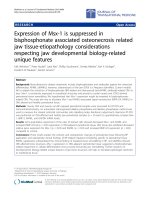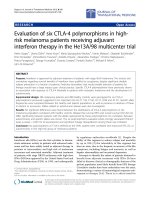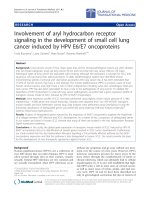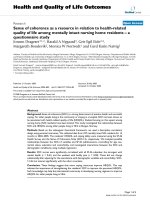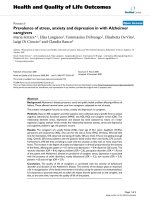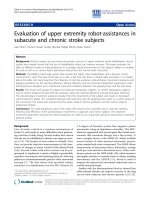báo cáo hóa học:" Outcome of Different Nevirapine Administration Strategies in Preventin g Mother-to-Child Transmission (PMTCT) Programs in Tanzania and Uganda" docx
Bạn đang xem bản rút gọn của tài liệu. Xem và tải ngay bản đầy đủ của tài liệu tại đây (293.92 KB, 8 trang )
BioMed Central
Page 1 of 8
(page number not for citation purposes)
Journal of the International AIDS Society
Open Access
Research article
Outcome of Different Nevirapine Administration Strategies in
Preventin g Mother-to-Child Transmission (PMTCT) Programs in
Tanzania and Uganda
Heiko Karcher
1
, Andrea Kunz
1
, Gabriele Poggensee
3
, Paulina Mbezi
4
,
Kizito Mugenyi
5
and Gundel Harms*
6
Address:
1
research associate, GTZ PMTCT Project, Institute of Tropical Medicine and International Health, Charité-University Medicine, Berlin,
Germany,
3
Associate Professor of Epidemiology, Department of Infectious Disease Epidemiology, Robert Koch-Institute, Berlin, Germany,
4
project
coordinator, MoH/GTZ PMTCT Programme, Mbeya Region, Mbeya, Tanzania,
5
project coordinator, MoH/GTZ PMTCT Programme, Western
Uganda, Fort Portal, Uganda and
6
Professor of Tropical Medicine; international coordinator, GTZ PMTCT Project, Institute of Tropical Medicine
and International Health, Charité-University Medicine, Berlin, Germany
Email: Gundel Harms* -
* Corresponding author
Abstract
Objective: Prevention-of-mother-to-child transmission (PMTCT) interventions based on single-
dose nevirapine (NVP) are widely implemented in Africa, but strategies differ regarding how and
when to administer the drug to women and infants. The aim of this study was to analyze the
outcome of different strategies with regard to NVP intake in pregnant women and their infants in
Tanzania and Uganda.
Methods: In an observational study carried out between March 2002 and December 2004, we
compared a directly observed NVP administration strategy in Tanzania (supervised NVP intake for
women and infants at a health unit) and a semi-observed administration strategy (self-administered
NVP for women at home and supervised intake for infants at a health unit) in Uganda.
Results: The proportions of HIV-positive women accepting receipt of NVP from the health units
were similar in the 2 countries (42.4% in Tanzania vs 45.6% in Uganda; P = .06). NVP intake in infants
was significantly higher in Tanzania than in Uganda (43.7% vs 24.1%; P < .001). In a multivariate
analysis, maternal age above 25 years, secondary education, Catholic faith, and having undergone
PMTCT counseling at a hospital were independently associated with infant NVP intake.
Conclusion: In our settings, the directly observed administration strategy resulted in a higher NVP
intake in infants. The semi-observed strategy, which implies that, after home delivery, the infant has
to be presented to a health unit for NVP administration, was less successful.
Introduction
Vertical transmission is one of the most important routes
of HIV-1 transmission in sub-Saharan Africa. Prevention-
of-mother-to-child transmission of HIV (PMTCT) pro-
grams based on the administration of a single dose of nev-
irapine (NVP) to the mother and her infant at delivery
have been adopted by many African countries as part of
their national PMTCT policies and guidelines.[1,2] Due to
the simplicity of NVP administration and low drug costs,
this strategy is considered to be exceptionally appropriate
Published: 12 April 2006
Journal of the International AIDS Society 2006, 8:12
This article is available from: />Journal of the International AIDS Society 2006, 8:12 />Page 2 of 8
(page number not for citation purposes)
for resource-poor settings. Despite growing skepticism
towards NVP because of the development of resistance in
the mother and increasing use of combination antiretro-
viral therapy in PMTCT prophylaxis, the NVP-based inter-
vention will remain the approach of choice in many
resource-limited settings for some time because a feasible
and affordable alternative is currently lacking.[3-8]
Most national PMTCT guidelines recommend the NVP-
based single-dose drug regimen for PMTCT intervention,
but national strategies of administering the drugs to the
pregnant women and their infants differ. Although of
high public health importance, the question of whether
and in which way different drug administration strategies
influence NVP intake has not yet been addressed.
Since 2001 the German Agency for Technical Co-opera-
tion and Development (GTZ) had supported NVP-based
PMTCT programs in rural areas of Tanzania and Uganda.
GTZ works in close cooperation with the Ministries of
Health of the partner countries, and the programs are inte-
grated into the existing governmental health facilities.
Additionally, long-term antiretroviral treatment for the
program participants and their families (PMTCT Plus
approach) was started in 2003 in the Tanzanian and
Ugandan sites.
The national PMTCT guidelines of the 2 countries recom-
mend different NVP administration strategies. In this
study we analyze the outcome of these different strategies
with regard to NVP intake in pregnant women and their
infants and factors possibly influencing the drug intake.
Methods
Study Population and Study Sites
An observational study design was used to compare NVP
intake of PMTCT program participants in Tanzania and
Uganda.
In Tanzania, the PMTCT intervention sites are in Mbeya
Region (Mbeya Referral Hospital, Vwawa Hospital,
Ruanda Health Centre, Igawilo Health Centre); in
Uganda, in Kabarole, Kyenjojo, and Kamwenge Districts
(Fort Portal Hospital, Virika Hospital, Kyenjojo Health
Centre, Rukunyu Health Centre, Kibiito Health Centre).
Program Setting
The PMTCT programs comprise voluntary HIV counseling
and testing for pregnant women and their husbands/part-
ners, administration of NVP to the women and their
infants, regular follow-up to counsel on infant feeding
options, cotrimoxazole prophylaxis for children of HIV-
positive mothers, management of infections and illnesses,
and support to the HIV-affected family. Pregnant women
are supposed to ingest a single tablet of 200 mg NVP at the
onset of labor, and the newborn should receive 2 mg/kg
of NVP syrup within 72 hours after birth.
The communities are continuously sensitized towards
PMTCT measures in workshops, seminars, by brochures,
leaflets, drama and theatre performances, and through
radio spots in local languages. Integration of the PMTCT
services into the existing health facilities demanded mod-
ification of space and reconstructions. Health personnel
underwent comprehensive PMTCT and counseling train-
ing, including HIV rapid testing and training in antiretro-
viral treatment.
National NVP Administration Strategies
In Tanzania, women have to give birth at the intervention
health units in order to receive the NVP tablet and syrup
for the child. NVP is not handed out to the pregnant
women in advance. The drugs are ingested under supervi-
sion of the health personnel (directly observed strategy)
and the mother and her infant are not discharged before
the drug is taken. In Uganda, the NVP tablet is handed to
the pregnant woman at the antenatal care (ANC) clinic at
week 28 of pregnancy. If she cannot deliver at an institu-
tion, she should take the NVP tablet at home. She is
advised to present herself at the health facility with the
newborn within 72 hours after birth in order to have the
NVP syrup administered to her infant by health personnel
(semi-observed strategy). In both countries NVP is admin-
istered to the infant within 72 hours after birth. In cases in
which the mother did not take the NVP tablet within the
recommended time frame (48 to 2 hours before delivery),
the infant dose is given directly after birth.
Data Collection
Specific program indicators (such as the number of initial
ANC visits, the number of ANC clients counseled for HIV/
PMTCT, the number of ANC clients tested for HIV infec-
tion, the number of ANC clients testing positive, the
number of ANC clients receiving NVP, and the number of
clients and infants who ingested NVP under supervision
of the health personnel or at home) were documented on
a monthly basis and collected between March 2002 and
December 2004 (observation period). For a subset of HIV-
positive women, sociodemographic data such as age, edu-
cational level, occupation, marital status, religion,
number of deliveries, and site of having undergone
PMTCT counseling were collected on standardized docu-
mentation forms at the ANC visit of the women, at deliv-
ery, and at each follow-up visit. Due to logistic
constraints, these data could only be collected from July to
December 2003. During this period, the data were consist-
Journal of the International AIDS Society 2006, 8:12 />Page 3 of 8
(page number not for citation purposes)
ently collected from all women of the observational
cohort presenting at the health units without further selec-
tion.
NVP Intake and Acceptance of NVP Intervention
NVP intake was defined as the proportion of women or
infants who ingested the NVP tablet or syrup, respectively,
after they had received it from the health personnel.
Because NVP administration to women and infants in
Tanzania and to infants in Uganda was supervised, exact
figures on NVP intake were available and defined as true
NVP intake. For women in Uganda, exact figures on NVP
intake were not available because clients were allowed to
self-administer NVP at home. For these clients, maximum
NVP intake was defined as the proportion of all women to
whom NVP was dispensed at the clinic at the ANC clinic
over all women who tested HIV-positive; minimum NVP
intake was defined as the proportion of women or infants
for whom data on NVP intake was available over all
women who tested HIV-positive.
Because the true intake in Tanzania and the maximum
intake in Uganda corresponded to the proportion of HIV-
positive women who were willing to receive the drug from
their caregivers with the intention to take it, these num-
bers were used to describe the acceptance of the NVP inter-
vention.
Statistical Analysis
Statistical analysis was performed using the SPSS program
version 11.5 (SPSS Inc.; Chicago, Illinois).
Pearson's x
2
test was used to compare categorical data.
Univariate analysis was performed to evaluate the socio-
demographic variables: age, level of education, occupa-
tion, marital status, religion, number of deliveries, and
PMTCT counseling site for the unadjusted association
with the intake of NVP in the infant. Multivariate adjusted
odds ratios were obtained from an unconditional logistic
regression model. Those variables significant in the uni-
variate analysis (P < .1) were included in the multivariate
model and adjusted for the countries.
The association of sociodemographic variables with
maternal NVP intake was not evaluated because, due to
the different drug administration strategies, the maternal
NVP intake was not comparable between the countries.
Ethical Considerations
This study was conducted according to the principles of
the Declaration of Helsinki. It was approved as part of the
evaluation protocol of the PMTCT programs by the
national and regional health authorities in Tanzania and
Uganda. Written informed consent for participation in the
program and its evaluation was obtained from all partici-
pating pregnant women.
Results
PMTCT Program Uptake
The total number of ANC attendees in each country, the
number of ANC attendees counseled and tested, and the
number of ANC attendees who tested HIV positive are
indicated in Figure 1.
True, Maximum, and Minimum NVP Intake
In Tanzania, 625 women and 645 infants of a total of
1475 HIV-positive women ingested NVP under supervi-
sion of the health personnel. The true NVP intake was
therefore 42.4% for women and 43.7% for infants (Figure
2).
In Uganda, 979 of 2148 HIV-positive women received the
NVP tablet at week 28 of pregnancy from the health per-
sonnel (Figure 2). Assuming that all women who received
NVP also ingested it, the maximum NVP intake for
women was therefore 45.6%. Of those women who tested
HIV-positive, 490 reported back to the health unit and
confirmed that they ingested the drug. The minimum
intake was thus 22.8%. A total of 518 infants of 2148 HIV-
positive mothers ingested NVP syrup. The true intake for
infants in Uganda was therefore 24.1%.
PMTCT program uptake in Tanzania and Uganda (March 2002December 2004)Figure 1
PMTCT program uptake in Tanzania and Uganda
(March 2002December 2004).
35000
29520
22664
22665
(76.7%)
11348
(50.1%)
13633
(60.2%)
9112
(80.3%)
2148
(15.8%)
1475
(16.2%)
30000
25000
20000
15000
10000
5000
0
Total Number of ANC
Attendees
ANC Attendees
Counseled
ANC Attendees
Tested for HIV
ANC Attendees
Tested Positive
Uganda
Tanzania
Journal of the International AIDS Society 2006, 8:12 />Page 4 of 8
(page number not for citation purposes)
The acceptance of the NVP intervention (true intake in
Tanzania and maximum intake in Uganda) did not differ
significantly between the countries (P = .06).
With regard to true NVP intake in infants, significantly
more infants in Tanzania than in Uganda ingested NVP
syrup (43.7% vs 24.1%; P < .001).
Sociodemographic Data
Detailed sociodemographic data were available from 337
HIV-positive ANC attendees in Tanzania and from 282 in
Uganda. The distribution of sociodemographic data dif-
fered significantly between the 2 countries (Table 1).
Maternal Factors Associated With NVP Intake in Infants
In univariate analyses, factors significantly associated with
NVP intake in Tanzania were maternal age above 25 years
(P = .02) and having undergone PMTCT counseling at a
hospital (as compared with a health center; P = .03). In
Uganda, age above 25 years (P = .04), secondary educa-
tion (as compared with primary; P = .01), and having
undergone PMTCT counseling at a hospital (as compared
with a health center; P = .03) were associated with NVP
intake. When adjusted for both countries, age above 25
years (P = .005), secondary education (P = .02), Catholic
faith (as compared with Protestant faith; P = .03), and
PMTCT counseling at a hospital (P = .005) retained signif-
icant influence in multivariate analysis (Table 2).
Discussion
The rates of women receiving NVP and the rates of women
and infants ingesting the drug were relatively low in all of
our settings and confirm the low uptake of the HIVNET
012 protocol in rural areas outside supervised research
conditions. In other African settings, rates of women
receiving the drug varied between 43% and 67%, and
rates of women and infants ingesting it varied between
15% and 40%.[12-17]
In this study, we compared different NVP administration
strategies in the GTZ-supported PMTCT programs in Tan-
zania and Uganda with regard to infant and maternal NVP
intake. While the NVP intake in infants was directly com-
parable between the 2 countries, this was not true for the
maternal NVP intake. Conclusions on how the different
strategies might have affected maternal NVP intake in the
2 countries can therefore only be drawn with caution.
The proportions of HIV-positive women accepting to
receive NVP from the PMTCT health units were similar in
the 2 countries (42.4% in Tanzania vs 45.6% in Uganda).
While it is unlikely that all women in Uganda who
received the NVP tablet also ingested it, it did occur in the
Tanzanian women due to the supervised drug administra-
tion strategy. Maternal NVP intake in the directly
observed, health unit-based approach in Tanzania may
therefore have been higher than under the semi-observed
approach in Uganda, although this assumption cannot be
proven from this study. Also, maternal NVP intake in
Uganda may have been higher than the documented
22.8% because probably not all women who ingested the
drug at home also reported back to the health units and
may therefore not have been counted.
The NVP intake in infants was significantly higher in the
directly observed approach in Tanzania than under the
semi-observed Ugandan approach (44% vs 24%). This
means that the different NVP administration strategies
may not have affected the acceptance of the NVP interven-
tion among the women as such, but presumably influ-
enced the virtual NVP intake in women and infants. Of
note, the access to the NVP intervention was more diffi-
cult for Tanzanian women because they had to come to
deliver at an intervention site in order to receive the drug.
Factors positively correlated with the administration of
NVP to the infants were: maternal age above 25 years, sec-
ondary education, Catholic faith, and undergoing PMTCT
counseling at a hospital. The influence of education on
PMTCT program uptake and NVP intake has been demon-
strated previously. In a Zambian study, illiterate women
were less likely to adhere to NVP intake, and in Côte
d'Ivoire illiteracy was associated with low uptake of the
PMTCT program package.[18,19] The latter study also
Comparison of true, maximum, and minimum NVP intake of PMTCT program participants in Tanzania and UgandaFigure 2
Comparison of true, maximum, and minimum NVP
intake of PMTCT program participants in Tanzania
and Uganda.
TANZANIA UGANDA
HIV-positive
1475
NVP taken:
Women
625 (42.4%)
NVP taken:
Infants
645 (43.7%)
True intake: Women
True intake: Infants
Minimum intake: Women
Maximum intake: Women
True intake: Infants
Directly-observed strategy
HIV-positive
2148
NVP taken:
Women
490 (22.8%)
NVP taken:
Infants
518 (24.1%)
Semi-observed strategy
NVP received
979 (45.6%)
Journal of the International AIDS Society 2006, 8:12 />Page 5 of 8
(page number not for citation purposes)
Table 1: Sociodemographic Data of HIV-Positive Clients per Country
Variable Tanzania (n = 337) Uganda (n = 282) P
Age .024
25 years 180 (53.4%) 125 (44.3%)
> 25 years 157 (46.6%) 157 (55.7%)
Education < .001
None 30 (8.9%) 55 (19.5%)
Primary 275 (81.6%) 159 (56.4%)
Secondary 32 (9.5%) 68 (24.1%)
Occupation < .001
Housewife 169 (50.1%) 175 (62.1%)
Farmer 111 (32.9%) 57 (20.2%)
Business woman 47 (13.9%) 28 (9.9%)
Other 10 (3.1%) 22 (7.8%)
Marital status < .001
Married 326 (96.7%) 239 (84.4%)
Single 11 (3.3%) 43 (15.2%)
Religion < .001
Protestant 121 (35.9%) 90 (31.9%)
Catholic 91 (27%) 145 (51.4%)
Muslim 25 (7.4%) 12 (4.3%)
Other 100 (29.7%) 35 (12.4%)
Number of deliveries .05
Primipara 25 (7.4%) 34 (12.1%)
Multipara 312 (92.6%) 248 (87.9%)
PMTCT counseling < .001
Hospital 121 (35.9%) 238 (84.4%)
Health center 216 (64.1%) 44 (15.6%)
Journal of the International AIDS Society 2006, 8:12 />Page 6 of 8
(page number not for citation purposes)
Table 2: Maternal Factors Associated With NVP Intake in Infants: Results of Univariate and Multivariate Analyses*
Tanzania Uganda Multivariate Analysis
Variable n %NVP intake OR 95% CI P n %NVP intake OR 95% CI P AOR 95% CI P
Age
25 years 180 22.8 1.00 125 25.6 1.00 1.00
> 25 years 157 34.4 1.78 1.102.87 .02 157 36.9 1.70 1.022.85 .04 1.68 1.172.42 .005
Education
Primary 257 26.5 1.00 159 27.0 1.00 1.00
None 30 40.0 1.85 0.854.02 .12 55 30.9 1.21 0.622.36 .58 1.28 0.742.20 .38
Secondary 32 31.3 1.26 0.572.78 .57 68 44.1 2.13 1.123.85 .01 1.83 1.123.00 .02
Occupation
Farmer 111 27.0 1.00 57 29.8 1.00
Housewife 169 29.0 1.10 0.651.88 .72 175 30.3 1.02 0.532.00 .95
Business woman 47 29.8 1.15 0.542.43 .72 28 42.9 1.77 0.704.51 .23
Other 10 20.0 0.68 1.143.36 .63 22 36.4 1.35 0.483.80 .58
Marital status
Single 11 9.1 1.00 43 34.9 1.00
Married 326 28.8 4.05 0.5132.1 .15 239 31.4 0.85 0.431.70 .65
Religion
Catholic 91 34.1 1.00 145 37.2 1.00 1.60 1.052.43 .03
Protestant 121 27.3 0.90 0.541.49 .67 90 25.6 0.58 0.321.03 .06 1.00
Muslim 25 28.0 0.88 0.372.10 .78 12 16.7 0.38 0.711.60 .15 0.82 0.351.90 .64
Other 100 24.0 0.78 0.461.33 .36 35 31.4 0.77 0.351.70 .52 0.85 0.491.47 .56
Number of deliveries
Multipara 312 27.6 1.00 248 31.5 1.00
Primipara 25 36.0 1.48 0.633.47 .37 34 35.3 1.19 0.562.52 .65
PMTCT counseling
Health center 216 24.1 1.00 44 18.2 1.00 1.00
Hospital 121 35.5 1.74 1.072.83 .03 238 34.5 2.37 1.055.33 .03 1.86 1.202.89 .005
*Multivariate analysis adjusted for the countries (Tanzania and Uganda)
OR = odds ratio; AOR = adjusted odds ratio; CI = confidence interval
Journal of the International AIDS Society 2006, 8:12 />Page 7 of 8
(page number not for citation purposes)
showed that women older than 25 years were more likely
to accept post-test counseling, while no association
between older maternal age or higher levels of education
and adherence to NVP intake was found in a Kenyan
study.[20] Reasons why maternal PMTCT counseling at a
hospital as compared with counseling at a health center
was associated with a higher NVP intake in infants may be
manifold. Knowledge and motivation of staff are usually
higher in a hospital, the setting more professional, and the
medical infrastructure more developed. This may have
positively influenced the quality of PMTCT counseling
and care, including drug administration. In addition, the
home distance of the clients to the urban hospitals may
have been shorter than to the rural health centers, making
women more likely to deliver at the hospital or to bring
their newborn for the NVP intervention. Sociocultural fac-
tors and fear of disclosure of the HIV status in the country-
side may have prevented women from delivering at the
intervention health units and from bringing their infants
for NVP administration.
Taken together, the factors associated with the administra-
tion of NVP to the infants remained independently asso-
ciated with NVP intake in infants in a multivariate
analysis after having adjusted for the countries. We there-
fore conclude that the differences in the sociodemo-
graphic maternal background in Tanzanian and Ugandan
women did not explain the higher NVP intake in Tanza-
nian as compared with Ugandan infants.
The higher intake may thus be attributable to the different
NVP administration strategy themselves. The current
study, however, was not a randomized trial, and further
possible confounders may not have been considered. One
such confounder may be the quality of counseling. Coun-
seling was performed by different counselors in at least 4
different PMTCT sites per country. Within the framework
of the program, counselors in the 2 countries were trained
uniformly and the counseling approach was standardized.
Although we cannot exclude an influence of the quality of
counseling on NVP acceptance and intake, we consider it
to be unlikely. Furthermore, the detailed sociodemo-
graphic data on which the multivariate analysis was based
were available from a subset of HIV-positive women of
the observation cohort only. However, because this socio-
demographic data were consistently collected for a spe-
cific period from all women of the observation cohort
without any selection, we assume that the subset was rep-
resentative for the entire cohort.
With regard to possible disadvantages of the 2 different
NVP administration strategies studied, it is interesting that
the more restricted approach, the directly observed NVP
administration in Tanzania, neither impeded women
from participating in the PMTCT intervention nor nega-
tively influenced the NVP intake. It should be noted, how-
ever, that the majority of Tanzanian women delivered at
home and had no access to the NVP intervention. The
benefit of the directly observed approach is therefore lim-
ited. The semi-observed NVP administration strategy in
Uganda which should facilitate the NVP intake in women
did not result in a high NVP intake in infants. Possibly,
once they have ingested the NVP tablet at home, women
may not feel the necessity to bring their newborns to the
health unit after delivery for the additional infant NVP
dose. Furthermore, travel to the health unit shortly after
delivery may be cumbersome for the women. The need to
explain to the husband or family why it is necessary to
take a healthy newborn to a health unit may be another
barrier, particularly because disclosure of the HIV status
may include isolation, expulsion from the family, and
violence against women.[21] Nevertheless, the extent to
which the efficacy of the NVP single dose is reduced when
only the mother took the drug vs both mother and child
receiving NVP is not known.
Conclusion
In our settings, the infant NVP intake in the directly
observed Tanzanian approach was higher than in the
semi-observed Ugandan approach. Furthermore, the Tan-
zanian strategy was possibly more beneficial regarding
maternal NVP intake than the Ugandan strategy. In both
countries, counseling activities, particularly for younger
women and those with lower educational levels, need to
be intensified in order to increase coverage of the PMTCT
programs. Additional approaches to improve program
uptake, such as "opt out" and intrapartum counseling and
testing, are to be adopted.[12,22-24] Furthermore, com-
plementary measures are necessary to better address
women who prefer to deliver at home, such as NVP home
administration by community volunteers or traditional
birth attendants.[25]
Authors and Disclosures
Heiko Karcher, MD, has disclosed no relevant financial
relationships.
Andrea Kunz, MD, MPH, has disclosed no relevant finan-
cial relationships.
Gabriele Poggensee, PhD, has disclosed no relevant finan-
cial relationships.
Paulina Mbezi, MD, has disclosed no relevant financial
relationships.
Kizito Mugenyi, MD, has disclosed no relevant financial
relationships.
Publish with BioMed Central and every
scientist can read your work free of charge
"BioMed Central will be the most significant development for
disseminating the results of biomedical research in our lifetime."
Sir Paul Nurse, Cancer Research UK
Your research papers will be:
available free of charge to the entire biomedical community
peer reviewed and published immediately upon acceptance
cited in PubMed and archived on PubMed Central
yours — you keep the copyright
Submit your manuscript here:
/>BioMedcentral
Journal of the International AIDS Society 2006, 8:12 />Page 8 of 8
(page number not for citation purposes)
Gundel Harms, MD, MPH, PhD, has disclosed no relevant
financial relationships.
Funding Information
The study was financially supported by the German Min-
istry for Economic Co-operation and Development
through the project PN 01.2029.5 (Prevention of mother-
to-child transmission of HIV).
Acknowledgements
The authors thank the authorities of Mbeya Region in Tanzania and of Kaba-
role, Kamwenge, and Kyenjojo Districts in Uganda for their continuous
cooperation. The work and effort of all health staff in the PMTCT interven-
tion sites, of nurses, midwives, and counselors, in particular, are highly
appreciated. The study was financially supported by the German Ministry
for Economic Co-operation and Development through the project PN
01.2029.5 (Prevention of mother-to-child transmission of HIV).
References
1. Guay LA, Musoke P, Fleming T, et al.: Intrapartum and neonatal
single-dose nevirapine compared with zidovudine for pre-
vention of mother-to-child transmission of HIV-1 in Kam-
pala, Uganda: HIVNET 012 randomised trial. Lancet 1999,
354:795-802. Abstract
2. Fowler MG, Mofenson L, McConnell M: The interface of perinatal
HIV prevention, antiretroviral drug resistance, and antiret-
roviral treatment: what do we really know? J Acquir Immune
Defic Syndr 2003, 34:308-311.
3. Eshleman SH, Mracna M, Guay LA, et al.: Selection and fading of
resistance mutations in women and infants receiving nevi-
rapine to prevent HIV-1 vertical transmission (HIVNET
012). AIDS 2001, 15:1951-1957. Abstract
4. Eshleman SH, Jackson JB: Nevirapine resistance after single dose
prophylaxis. AIDS Rev 2002, 4:59-63. Abstract
5. Cunningham CK, Chaix ML, Rekacewicz C, et al.: Development of
resistance mutations in women receiving standard antiret-
roviral therapy who received intrapartum nevirapine to pre-
vent perinatal human immunodeficiency virus type 1
transmission: a substudy of pediatric AIDS clinical trials
group protocol 316. J Infect Dis 2002, 186:181-188. Abstract
6. Morris L, Pillay C, Chezzi C, et al.: Low frequency of the V106M
mutation among HIV-1 subtype C-infected pregnant women
exposed to nevirapine. AIDS 2003, 17:1698-1700. Abstract
7. Jourdain G, Ngo-Giang-Huong N, Le Coeur S, et al.: Intrapartum
exposure to nevirapine and subsequent maternal responses
to nevirapine-based antiretroviral therapy. N Engl J Med 2004,
351:229-240. Abstract
8. World Health Organization: Antiretroviral drugs for treating
pregnant women and preventing HIV infection infants. Guide-
lines on care, treatment and support for women living with HIV/AIDS and
their children in resource-constrained settings 2004 [ />hiv/pub/mtct/en/arvdrugswomenguidelinesfinal.pdf]. Geneva: WHO
Accessed March 8, 2005
9. HIV/AIDS/STI Surveillance Report. In National AIDS Control Pro-
gramme Ministry of Health, Tanzania; 2003. Report Number 17
10. HIV/AIDS Surveillance Report. In STD/AIDS Control Programme
Ministry of Health, Kampala, Uganda; 2003.
11. Wiktor SZ, Ekpini E, Nduati RW: Prevention of mother-to-child
transmission of HIV-1 in Africa. AIDS 1997, 11(suppl
B):S79-S87. Abstract
12. Temmerman M, Quaghebeur A, Mwanyumba F, Mandaliya K:
Mother-to-child HIV transmission in resource poor settings:
how to improve coverage? AIDS 2003, 17:1239-1242.
13. Stringer EM, Sinkala M, Stringer JS, et al.: Prevention of mother-to-
child transmission of HIV in Africa: successes and challenges
in scaling-up a nevirapine-based program in Lusaka, Zambia.
AIDS 2003, 17:1377-1382. Abstract
14. Malonza IM, Richardson BA, Kreiss JK, Bwayo JJ, Stewart GC: The
effect of rapid HIV-1 testing on uptake of perinatal HIV-1
interventions: a randomized clinical trial. AIDS 2003,
17:113-118. Abstract
15. Farquhar C, Kiarie JN, Richardson BA, et al.: Antenatal couple
counseling increases uptake of interventions to prevent HIV-
1 transmission. J Acquir Immune Defic Syndr 2004, 37:1620-1626.
Abstract
16. Perez F, Mukotekwa T, Miller A, et al.: Implementing a rural pro-
gramme of prevention of mother-to-child transmission of
HIV in Zimbabwe: first 18 months of experience. Trop Med Int
Health 2004, 9:774-783. Abstract
17. Quaghebeur A, Mutunga L, Mwanyumba F, Mandaliya K, Verhofstede
C, Temmerman M: Low efficacy of nevirapine (HIVNET012) in
preventing perinatal HIV-1 transmission in a real-life situa-
tion. AIDS 2004, 18:1854-1856. Abstract
18. Stringer JS, Sinkala M, Stout JP, et al.: Comparison of two strate-
gies for administering nevirapine to prevent perinatal HIV
transmission in high-prevalence, resource-poor settings. J
Acquir Immune Defic Syndr 2003, 32:506-513. Abstract
19. Ekouevi DK, Leroy V, Viho A, et al.: Acceptability and uptake of
a package to prevent mother-to-child transmission using
rapid HIV testing in Abidjan, Cote d'Ivoire. AIDS 2004,
18:697-700. Abstract
20. Kiarie JN, Kreiss JK, Richardson BA, John-Stewart GC: Compliance
with antiretroviral regimens to prevent perinatal HIV-1
transmission in Kenya. AIDS 2003, 17:65-71. Abstract
21. Gaillard P, Melis R, Mwanyumba F, et al.: Vulnerability of women
in an African setting: lessons for mother-to-child HIV trans-
mission programmes. AIDS 2002, 16:937-939. Abstract
22. Manzi M, Zachariah R, Teck R, et al.: High acceptability of volun-
tary counselling and HIV-testing but unacceptable loss to fol-
low up in a prevention of mother-to-child HIV transmission
programme in rural Malawi: scaling-up requires a different
way of acting. Trop Med Int Health 2005, 10:1242-1259. Abstract
23. Centers for Disease Control and Prevention (CDC): Introduction
of routine HIV testing in prenatal care-Botswana, 2004.
MMWR Morb Mortal Wkly Rep 2004, 53:1083-1086. Abstract
24. Van't Hoog AH, Mbori-Ngacha DA, Marum LH, et al.: Preventing
mother-to-child transmission of HIV in Western Kenya:
operational issues. J Acquir Immune Defic Syndr 2005, 40:344-349.
Abstract
25. Kironde S, Lukwago J, Ssenyonga R: Scaling the frontier should
traditional birth attendants also be used to provide nevirap-
ine for PMTCT in Uganda? Afr Health Sci 2003, 3:102-103.


